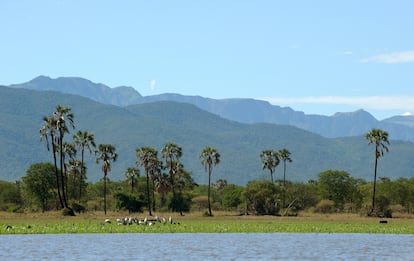The discovery of a paradise of islands without sea: the South East Africa Montane Archipelago
Two decades of expeditions by a hundred scientists have revealed the continent’s most endangered ecoregion, home to dozens of endemic species existing in an ocean of grass

There is a place in the world where all the forces of nature converge and create an environment that is so unique that it is home to more animals than anywhere else on the planet. Volcanoes covered by tropical rainforests stand above an ocean brimming with coral reefs, and ecosystems intertwine to create an unparalleled biodiversity. This is Insulindia, or the Malay Archipelago, the land of 25,000 islands that were explored by Alfred Russel Wallace between 1854 and 1862 and where he made some of the most important scientific discoveries of his time.
Wallace traveled in a relentless quest to demonstrate how geography affects the ranges of species, conditions their origins and multiplies their diversity. Meanwhile, from his home in Downe (Kent, U.K.), another naturalist, Charles Darwin, was gathering the infinite amount of evidence and arguments that would support the publication of On The Origin of Species, the book that conceptually transformed the world, in 1859. Whenever he embarked on an expedition, Darwin carried with him a copy of John Milton’s Paradise Lost.
It was in the Galápagos Islands where Darwin’s nemesis came about, the shift from a timorous religious mentality to an openly heterodox one in which biological inheritance replaced the hand of the divine watchmaker. The Galápagos, a lost paradise in the middle of the Pacific that, in the eyes of the young naturalist, emerged as a laboratory of evolution. Although the Beagle spent only five weeks in the Galápagos during its five-year voyage, about a quarter of Darwin’s notes and field journal are devoted to this location. He had stumbled upon one of evolution’s primeval paradises, and there he began to throw Milton’s creationist cargo overboard. Considering the astonishment that Wallace and Darwin felt in their respective island paradises, it is easier to understand the wonder that the naturalists must have felt when they described a new paradise of islands without a sea.
This is the South East Africa Montane Archipelago (SEAMA). The landscape of the new ecoregion is made up of 30 granite hills, some of which are over 3,000 meters high. They are inselbergs or monadnocks, isolated hills that dominate the plain, batholiths formed between 600 and 125 million years ago. Today, the 30 hills are home to the largest (Mount Mabu) and smallest (Mount Lico) evergreen montane rainforests in southern Africa. Further up the hill, above these primeval forests, biologically unique subalpine grasslands flourish.
In Africa, mountains often accommodate relict forests (the last refuge of species), remnants of a vast Tertiary forest belt. Before the elevation and progressive increase in barrenness of the eastern plateaus, the forest had covered most of the continent.
During the early Oligocene epoch, as the global climate cooled, the Pan-African rainforests began to fragment. This triggered a significant reduction of forests throughout the Miocene.
Forest fragmentation resulted in the “islands in the sky” that are home to the unique biodiversity observed today. A large part of the original forest in East Africa was confined to these isolated mountainous pockets that survived thanks to orographic precipitation.
Immersed in these small, confined forests, constrained by their low dispersal capacity, some species were trapped in upland refuges. Here the trade winds, loaded with humidity, sustained a relatively stable climate.
Later climatic fluctuations, throughout the late Cenozoic era, hindered gene flow, the migration of genes, between members of the same species found in adjacent mountains. Each of these rock islands became an evolutionary hub that favored allopatric speciation (caused by the presence of a geographic barrier). This resulted in the establishment of unique habitats, rich in endemic species: reptiles, amphibians, mammals, crabs and butterflies that now characterize the African montane systems.
The treasures of paradise
The 3,300 square kilometers over which this relatively small ecoregion stretches are home to 30 species of strictly endemic butterflies, which only exist in the Montane Archipelago; six species of freshwater crabs; 11 species of amphibians; 22 new species of reptiles, including a new diminutive pygmy chameleon (Rhampholeon maspictus); four new species of mammals; and 117 species of strictly endemic plants. This is a remarkably high number considering how limited the geographic area is. This figure is likely to increase when sampling of some groups of cryptogams (seedless plants) and invertebrates that require the analysis of specialized taxonomic groups is incorporated.
The endemic composition as a whole is a consequence of the isolation of the highlands, separated since the Cenozoic from the rest of the Pan-African forests by the immense savanna-covered plains, a sea of grass whose seasonal aridity hinders the development of forest biomes.
But it is not all good news. Despite having global biodiversity importance and the efforts of the governments of Malawi and Mozambique, the ecoregion remains severely under threat. Since scientists began their studies 20 years ago, the mountains, suppressed under pressure from slash-and-burn agriculture, hunting and demand for fuel and timber, have shed one-fifth of their rainforest cover, nearly half in some cases, one of the highest deforestation rates in Africa. If the pattern does not change, the new ecoregion, a biodiversity Eden, may become, like Milton’s, yet another paradise lost. The species condemned to millions of years of solitude do not get a second chance on Earth.
Sign up for our weekly newsletter to get more English-language news coverage from EL PAÍS USA Edition
Tu suscripción se está usando en otro dispositivo
¿Quieres añadir otro usuario a tu suscripción?
Si continúas leyendo en este dispositivo, no se podrá leer en el otro.
FlechaTu suscripción se está usando en otro dispositivo y solo puedes acceder a EL PAÍS desde un dispositivo a la vez.
Si quieres compartir tu cuenta, cambia tu suscripción a la modalidad Premium, así podrás añadir otro usuario. Cada uno accederá con su propia cuenta de email, lo que os permitirá personalizar vuestra experiencia en EL PAÍS.
¿Tienes una suscripción de empresa? Accede aquí para contratar más cuentas.
En el caso de no saber quién está usando tu cuenta, te recomendamos cambiar tu contraseña aquí.
Si decides continuar compartiendo tu cuenta, este mensaje se mostrará en tu dispositivo y en el de la otra persona que está usando tu cuenta de forma indefinida, afectando a tu experiencia de lectura. Puedes consultar aquí los términos y condiciones de la suscripción digital.
More information










































